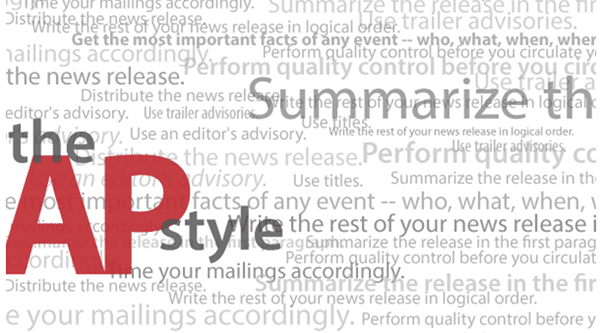
What is AP Style Content?
There are a number of different writing styles established by publications and news services. Those who write for these publications are expected to adhere to the style manual. Learning the basics of the AP style manual could help you get more media coverage because journalists who want to use your press release for their own audience won’t have to do so much editing.
What is the AP?
The Associated Press (AP) was founded in 1848 as a cooperative amongst six New York newspapers which decided to pool their resources in order to gather international news. Now it is the world’s largest news organization, with more than 3700 employees in 121 countries. Their newswire service is used by thousands of media outlets, resulting in an audience of more than 1 billion people daily.
What are the essentials of AP style?
AP writers need to be clear, concise, accurate, and unbiased. AP style outlines grammar, usage, spelling, punctuation, and certain conventions. It is used by most U.S. newspapers, magazines and public relations (PR) firms presenting thing like press releases.
Here are a few of the important rules that can help you keep your press releases looking professional.
Places
-
Addresses
Abbreviate the words street, avenue and boulevard only if the address is numbered: 9411 Shore Avenue.
Never abbreviate drive, highway, place, and so on:
1314 Sycamore Drive
Abbreviate compass directions in numbered addresses: 100 W. Court St (West)
-
States
Spell out names of states unless there is a city, county or military base name in front of it. New York (State) Albany, N.Y.
Spell out Alaska, Hawaii, and states with five or fewer letters.
Use the approved abbreviations according to the AP, such as N.Y., not NY.
Days and dates
Always use numerals without st, nd, rd or th in dates. April 2, 2018, not April 2nd.
Try not to use words like yesterday, today and tomorrow because story publication could be delayed.
Use months and dates: “May 30” and “July 5.”
If using month, day and year, set off the year with commas: Aug. 5, 1962, was the day Marilyn Monroe died.
-
Months
Abbreviate only if the month’s name is six letters or longer and has a number: September, vs. Sept. 6.
-
TIME: Years
Add an “s” to first year in the decade: 1910s.
Never spell out years, even at the start of a sentence. Always use figures: 1941 saw the Dunkirk evacuation and the Battle of Britain, the darkest days of the war.
Numbers
Spell out:
Whole numbers below 10: seven
Numerals that start a sentence: Ten walruses were spotted on the beach.
For large numbers use a hyphen to connect the word ending in y to another word: Thirty-four
-
Use figures:
For 10 and above: 22 cats
For all ages and percentages (even less than 10). A 9-year old child, 22%
TIME: a.m. vs. p.m.
“8 p.m. tonight” is redundant. We already know it is evening. Write 8 p.m. and the day instead, such as Tuesday.
*Use figures except for noon and midnight
*Write the time of day like this: 2:30 a.m. or 8:45 p.m. You can use a 24-clock if you wish to save space:
The attack started at 20:45 local time.
TITLES OF BOOKS AND PUBLICATIONS
Always capitalize the first and last word of the title.
Capitalize all words four letters or longer.
Do not capitalize articles “a,” “an” and “the” OR conjunctions or prepositions unless they are four letters or longer, such as From and With.
TITLES OF PEOPLE
Capitalize formal titles before a name and do not separate the title from the name with a comma.
- Mr. Obama
- Ms. Streep
- President Obama.
- Prince Charles.
- Dr. Eric Topol
There are various rules when addressing royalty or referring to them. See the AP Stylebook.
Here is a handy quick reference guide to help you check your work before publishing it: https://owl.english.purdue.edu/owl/resource/735/02/
You can also buy the annual handbook, or subscribe to the website, where you can search for the handbook, get access to experts, and more. https://www.apstylebook.com/




